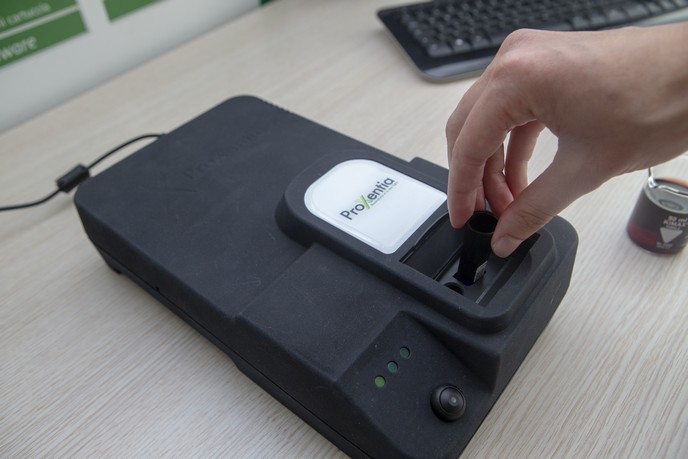New, ex vivo diagnostic system helps predict cancer patient response to treatment
Cellply’s product, developed through the EU-funded ONCOSMART (ONCOlogic patient profiling and personalised treatment through SMART bedside diagnostics) project, provides a response to a long-standing issue. Until now, we have known that about 30-40 % of cancer patients present specific mutations that could be the focus of targeted therapies and immunotherapy. Information about this mutational status is precious: for instance, physicians have known that KRAS mutation could be targeted by anti-EGFR antibodies, but KRAS itself is not a good biomarker for predicting tumour response to therapy. Similarly, the efficacy of anti-PD1 immunotherapies has a poor correlation with the expression of PD1. As a result, mutational profiles are rarely useful as biomarkers for predicting therapy outcome. ‘More complex strategies are being investigated, such as next-generation sequencing, demonstrating that the combination of multiple information is needed to achieve biomarkers with higher predictive power, but results of the application of such an approach are still not satisfactory in many clinical situations. On the other hand, chemotherapies are still widely in use, both in the remaining 60-70 % of patients and in refractory or relapsed patients. But patient stratification in these cases is mostly based on risk assessment or prognostic factors, and other approaches for guiding therapy selection are lacking in the clinic,’ Massimo Bocchi, CEO of Cellply, explains. For Mr Bocchi, the solution lies in ex vivo/in vitro analysis of drug response, to extract a new layer of information which relies on phenotype more than genotype. The latter is applicable to both new-generation drugs and chemotherapies, and it allows for investigating the effects of dosage or combinations of drugs on the clinical outcome. And whilst such an approach had already been explored with limited success, recent advances in life sciences allow for the development of effective test methods which are sometimes even superior to molecular approaches. By combining the two, Bocchi believes that his company may have a winning, hybrid approach in its hands. A groundbreaking, lab-on-a-chip device ‘Cellply is developing the first fully-automated diagnostic system to evaluate the response of fresh tumour specimens to anticancer drugs in the clinical setting,’ Andrea Faenza, CTO of Cellply, enthuses. The system allows for conducting drug testing in the clinical setting just a few hours after obtaining the tumour specimen, thus minimising drifts in cell function that typically increase with time from sampling. The result is provided within the following 24 to 48 hours. ‘By integrating an entire laboratory procedure in a lab-on-a-chip device, we can test three to four drugs or drug combinations in parallel at different dosages with only one biopsy. Moreover, lab-on-a-chip automation standardises sample preparation and analytical procedures, allowing us to overcome the limitation of other lab-based drug testing assays which are difficult to compare to each other and to be deemed as a possible reference diagnostic procedure,’ Faenza says. Thanks to funding under the SME Instrument, the company was able to preliminarily assess the impact of our approach on both the healthcare system and the pharmaceutical industry. The team held discussions with haemato-oncologists, laboratory technicians and stakeholders from the pharmaceutical industry as well as experienced entrepreneurs, and identified their needs. Cellply was then able to adjust its business model and go-to-market strategy, taking into account the use of their system both for personalised medicine applications and for supporting pharmaceutical companies during the development of new anti-cancer drugs. ‘We found that clinicians, in particular in clinical situations where chemotherapies are used, need to support their decision with new personalised tests indicating which therapeutic options are more likely to be effective on a patient-by-patient basis,’ Laura Rocchi, Head of Biology at Cellply, explains. ‘Pharmaceutical companies, on the other hand, see the approach as possibly valuable for designing better clinical trials, for example by discarding non-responding patients from the trial or by stratifying patients according to expected dosage information.’ Several drug developers also seem interested in getting a preview of drug efficacy on human samples at late-preclinical stage, before moving on with a first-in-man trial. Finally, the technology was considered of interest for possibly identifying other biomarkers through analysing the correlation between ex vivo response and mutational status. So what’s next for Cellply? ‘A prototype system was implemented and tested on 10 acute myeloid leukaemia (AML) patients, showing a correct prediction of patient response in 90 % of cases. The next step would be to industrialise and clinically validate the platform on a first large set of patients in 2018-2019, in order to achieve regulatory clearance in Europe and the USA. In parallel, Cellply will keep working with pharmaceutical companies to support their drug development processes,’ Bocchi explains.
Keywords
Cellply, ONCOSMART, cancer, ex vivo diagnostic, biomarkers, prediction, tumour response







